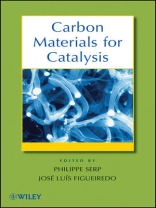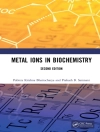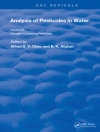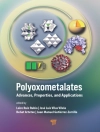This is the first comprehensive book covering all aspects of the use of carbonaceous materials in heterogeneous catalysis. It covers the preparation and characterization of carbon supports and carbon-supported catalysts; carbon surface chemistry in catalysis; the description of catalytic, photo-catalytic, or electro-catalytic reactions, including the development of new carbon materials such as carbon xerogels, aerogels, or carbon nanotubes; and new carbon-based materials in catalytic or adsorption processes. This is a premier reference for carbon, inorganic, and physical chemists, materials scientists and engineers, chemical engineers, and others.
İçerik tablosu
Contributors xv
Preface xix
1 Physicochemical Properties of Carbon Materials: A Brief Overview 1
Ljubisa R. Radovic
1.1. Introduction 1
1.2. Formation of Carbons 2
1.2.1. Gas Phase 2
1.2.2. Liquid Phase 3
1.2.3. Solid Phase 4
1.3. Structure and Properties of Carbons 5
1.3.1. Macrostructure 5
1.3.2. Microstructure 8
1.3.3. Nanostructure 8
1.3.4. Bulk Properties 16
1.3.5. Surface Properties 19
1.4. Reactions of Carbons 23
1.4.1. Gas Phase 23
1.4.2. Liquid Phase 25
1.4.3. Solid Phase 27
1.5. Conclusions 33
References 34
2 Surface Chemistry of Carbon Materials 45
Teresa J. Bandosz
2.1. Introduction 45
2.2. Surface Functionalities 47
2.2.1. Oxygen-Containing Functionalities 48
2.2.2. Nitrogen-Containing Functionalities 50
2.2.3. Hydrogen–Carbon Species 51
2.2.4. Sulfur Phosphorus and Halogen Functionalities 51
2.3. Surface Modifications 54
2.3.1. Oxidation 54
2.3.2. Introduction of Nitrogen-Containing Species 55
2.3.3. Introduction of Sulfur Functionality 55
2.3.4. Halogenization 56
2.3.5. Impregnation and Dry Mixing 56
2.3.6. Heat Treatment 56
2.4. Characterization of Surface Chemistry 58
2.4.1. Elemental Analysis 58
2.4.2. Titration 58
2.4.3. p H of Carbons Point of Zero Charge and Isoelectric Point 61
2.4.4. Spectroscopic Methods 63
2.4.5. Calorimetric Techniques 72
2.4.6. Inverse Gas Chromatography 75
2.4.7. Temperature-Programmed Desorption 75
2.4.8. Characterization of Surface Functionalities by Electrochemical Techniques 78
2.5. Role of Surface Chemistry in the Reactive Adsorption on Activated Carbons 78
2.6. Role of Carbon Surface Chemistry in Catalysis 80
References 82
3 Molecular Simulations Applied to Adsorption on and Reaction with Carbon 93
Zhonghua (John) Zhu
3.1. Introduction 93
3.2. Molecular Simulation Methods Applied to Carbon Reactions 94
3.2.1. Electronic Structure Methods (or Quantum Mechanics Methods) 94
3.2.2. Molecular Dynamics Simulations 97
3.2.3. Monte Carlo Simulations 98
3.3. Hydrogen Adsorption on and Reaction with Carbon 98
3.3.1. Atomic Hydrogen Adsorption on the Basal Plane of Graphite 98
3.3.2. Reactivities of Graphite Edge Sites and Hydrogen Reactions on These Sites 101
3.3.3. Hydrogen Storage in Carbon Nanotubes 104
3.4. Carbon Reactions with Oxygen-Containing Gases 105
3.4.1. Carbon Reactions with Oxygen-Containing Gases and the Unified Mechanism 106
3.4.2. Catalyzed Gas–Carbon Reactions 110
3.4.3. More Specific Studies on NOx, H2, CO2, and O2–Carbon Reactions 118
3.5. Metal–Carbon Interactions 122
3.6. Conclusions 125
References 126
4 Carbon as Catalyst Support 131
Francisco Rodríguez-Reinoso and Antonio Sepúlveda-Escribano
4.1. Introduction 131
4.2. Properties Affecting Carbon’s Role as Catalyst Support 132
4.2.1. Surface Area and Porosity 132
4.2.2. Surface Chemical Properties 134
4.2.3. Inertness 136
4.3. Preparation of Carbon-Supported Catalysts 137
4.3.1. Impregnation 137
4.3.2. Other Methods 139
4.4. Applications 140
4.4.1. Ammonia Synthesis 141
4.4.2. Hydrotreating Reactions 143
4.4.3. Hydrogenation Reactions 147
4.5. Summary 150
References 150
5 Preparation of Carbon-Supported Metal Catalysts 157
Johannes H. Bitter and Krijn P. de Jong
5.1. Introduction 157
5.2. Impregnation and Adsorption 157
5.2.1. Interaction Between Support and Precursor 158
5.2.2. Role of Pore Structure 164
5.3. Deposition Precipitation 165
5.3.1. Increase in p H 166
5.3.2. Change of Valency 169
5.3.3. Ligand Removal 170
5.4. Emerging Preparation Methods 171
5.5. Conclusions 172
References 173
6 Carbon as Catalyst 177
José Luís Figueiredo and Manuel Fernando R. Pereira
6.1. Introduction 177
6.2. Factors Affecting the Performance of a Carbon Catalyst 178
6.2.1. Nature of the Active Sites 178
6.2.2. Concentration of the Active Sites 179
6.2.3. Accessibility of the Active Sites 179
6.3. Reactions Catalyzed by Carbons 180
6.3.1. Oxidative Dehydrogenation 181
6.3.2. Dehydration of Alcohols 186
6.3.3. SOx Oxidation 188
6.3.4. NOx Reduction 190
6.3.5. H2S Oxidation 194
6.3.6. Hydrogen Peroxide Reactions 196
6.3.7. Catalytic Ozonation 198
6.3.8. Catalytic Wet Air Oxidation 203
6.3.9. Other Reactions 205
6.4. Conclusions 207
References 208
7 Catalytic Properties of Nitrogen-Containing Carbons 219
Hanns-Peter Boehm
7.1. Introduction 219
7.2. Nitrogen Doping of Carbons 220
7.2.1. Preparation of Nitrogen-Containing Carbons 220
7.2.2. Quantitative Analysis 227
7.2.3. Electron Emission Spectrometric Analysis 227
7.2.4. Properties of Nitrogen-Containing Carbons 233
7.3. Catalysis of Oxidation Reactions with Dioxygen 238
7.3.1. Oxidation of Aqueous Sulfurous Acid 238
7.3.2. Oxidation of Oxalic Acid 244
7.3.3. Oxidation of Sulfur Dioxide 244
7.3.4. Oxidation of Iron(II) Ions 246
7.3.5. Oxidation of Other Compounds 247
7.4. Catalysis of Aging of Carbons 251
7.5. Catalysis of Dehydrochlorination Reactions 254
7.6. Mechanism of Catalysis by Nitrogen-Containing Carbons 257
References 259
8 Carbon-Anchored Metal Complex Catalysts 267
Cristina Freire and Ana Rosa Silva
8.1. Introduction 267
8.2. General Methods for Molecule Immobilization 268
8.3. Methods for Immobilization of Transition-Metal Complexes Onto Carbon Materials 270
8.3.1. Functionalization of Carbon Materials 271
8.3.2. Direct Immobilization of Metal Complexes 278
8.3.3. Metal Complex Immobilization via Spacers 285
8.4. Application of Coordination Compounds Anchored Onto Carbon Materials in Several Catalytic Reactions 289
8.4.1. [M(salen)]-Based Materials 290
8.4.2. [M(acac)2]-Based Materials 293
8.4.3. Metal Phthalocyanine and Porphyrin-Based Materials 294
8.5. Application of Carbon-Supported Organometallic Compounds in Hydrogenation and Hydroformylation Catalytic Reactions 296
8.5.1. Materials Based on Pd and Rh Amino Complexes 296
8.5.2. Materials Based on Rh and Pd Complexes with π-Bonding Ligands (Phosphines and Dienes) 297
8.6. Carbon-Supported Organometallic Complexes in the Polymerization Reaction of Olefins 300
8.7. Conclusions 301
References 302
9 Carbon Nanotubes and Nanofibers in Catalysis 309
Philippe Serp
9.1. Introduction 309
9.2. Catalytic Growth of Carbon Nanofibers and Nanotubes 312
9.2.1. Catalytic Carbon Deposition 312
9.2.2. Growth Mechanism 313
9.3. Why CNTs or CNFs Can Be Suitable for Use in Catalysis 324
9.3.1. Structural Features and Electronic Properties 324
9.3.2. Adsorption Properties 328
9.3.3. Mechanical and Thermal Properties 330
9.3.4. Macroscopic Shaping of CNTs and CNFs 331
9.4. Preparation of Supported Catalysts on CNTs and CNFs 333
9.5. Catalytic Performance of CNT- and CNF-Based Catalysts 340
9.5.1. Hydrogenation Reactions 340
9.5.2. Reactions Involving CO/H2 344
9.5.3. Polymerization 345
9.5.4. Carbon Nanotubes Synthesis by Catalytic Decomposition of Hydrocarbons 348
9.5.5. Ammonia Synthesis and Decomposition 349
9.5.6. Environmental Catalysis and Oxidation Reactions 350
9.5.7. Other Reactions 351
9.5.8. Fuel Cell Electrocatalysts 354
9.5.9. CNTs for Enzyme Immobilization 355
9.5.10. CNTs and CNFs as Catalysts 356
9.6. Conclusions 356
References 358
10 Carbon Gels in Catalysis 373
Carlos Moreno-Castilla
10.1. Introduction 373
10.2. Carbon Gels: Preparation and Surface Properties 374
10.3. Metal-Doped Carbon Gels 376
10.3.1. Dissolving the Metal Precursor in the Initial Mixture 378
10.3.2. Introducing a Functionalized Moiety 381
10.3.3. Depositing the Metal Precursor on the Organic or Carbon Gel 382
10.4. Catalytic Reactions of Metal-Doped Carbon Gels 383
10.4.1. Environmental Applications 384
10.4.2. Fuel Cell Applications 387
10.4.3. C=C Double-Bond Hydrogenation 389
10.4.4. Skeletal Isomerization of 1-Butene 391
10.4.5. Hydrodechlorination Reaction 392
10.4.6. Other Reactions 392
10.5. Conclusions 393
References 395
11 Carbon Monoliths in Catalysis 401
Karen M. de Lathouder Edwin Crezee Freek Kapteijn and Jacob A. Moulijn
11.1. Introduction 401
11.2. Carbon 401
11.3. Monolithic Structures 402
11.4. Carbon Monoliths 402
11.5. Carbon Monoliths in Catalysis: An Overview 404
11.6. Example of Carbon Monoliths as Catalyst Support Material 405
11.6.1. Carbon Monoliths as Support Material in Biocatalysis 405
11.6.2. Selective Hydrogenation of D-Glucose over Monolithic Ruthenium Catalysts 405
11.6.3. Performance of Carbon Monoliths 406
11.6.4. Morphology and Porosity of Various Carbon Composites 407
11.6.5. Enzyme Adsorption and Catalyst Performance in the Msr 413
11.6.6. Performance of Monolithic Ruthenium Catalysts 416
11.7. Evaluation and Practical Considerations 420
11.7.1. Monolithic Biocatalysts 420
11.7.2. Monolithic Ruthenium Catalysts 421
11.7.3. Practical Considerations 421
11.8. Conclusions 423
References 424
12 Carbon Materials as Supports for Fuel Cell Electrocatalysts 429
Frédéric Maillard Pavel A. Simonov and Elena R. Savinova
12.1. Introduction 429
12.2. Structure and Morphology of Carbon Materials 433
12.2.1. Carbon Blacks 433
12.2.2. Activated Carbons 434
12.2.3. Carbons of the Sibunit Family 435
12.2.4. Ordered Mesoporous Carbons 436
12.2.5. Carbon Aerogels 436
12.2.6. Carbon Nanotubes and Nanofibers 437
12.3. Physicochemical Properties of Carbon Materials Relevant to Fuel Cell Operation 438
12.3.1. Electron Conduction 438
12.3.2. Surface Properties 440
12.4. Preparation of Carbon-Supported Electrocatalysts 443
12.4.1. Methods Based on Impregnation 444
12.4.2. Colloidal Synthesis 445
12.4.3. Electrodeposition 445
12.4.4. Other Methods 446
12.5. Structural Characterization of Carbon-Supported Metal Catalysts 446
12.5.1. Adsorption Studies 447
12.5.2. Transmission Electron Microscopy 448
12.5.3. Xray Diffraction and Xray Absorption Spectroscopy 449
12.5.4. Electrochemical Methods 450
12.6. Influence of Carbon Supports on the Catalytic Layers in PEMFCs 452
12.6.1. Intrinsic Catalytic Activity 452
12.6.2. Macrokinetic Parameters 456
12.6.3. Novel Carbon Materials as Supports for Fuel Cell Electrocatalysts 462
12.7. Corrosion and Stability of Carbon-Supported Catalysts 464
12.7.1. Influence of Microstructure on the Corrosion of Carbon Materials 464
12.7.2. Mechanism of Carbon Corrosion 466
12.7.3. Corrosion and Stability of MEAs 467
12.8. Conclusions 469
References 470
13 Carbon Materials in Photocatalysis 481
Joaquim Luís Faria and Wendong Wang
13.1. Introduction 481
13.2. Carbon Materials Employed to Modify Ti O2 in Photocatalysis 482
13.2.1. Activated Carbon 482
13.2.2. Carbon Black and Graphite 483
13.2.3. Carbon Fiber 483
13.2.4. Carbon Nanotubes 483
13.2.5. Other Forms of Carbon 484
13.3. Synthesis and Characterization of Carbon–Ti O2 Composites 484
13.3.1. Mechanical Mixture of Ti O2 and Carbon Materials 485
13.3.2. Ti O2 Coated or Loaded on Carbon Materials 485
13.3.3. Carbon Materials Coated or Deposited on Ti O2 485
13.3.4. Other Approaches and Concurrent Synthesis of Ti O2–Carbon Composites 486
13.3.5. Methods of Characterization 486
13.4. Photodegradation on Carbon-Containing Surfaces 487
13.4.1. Heterogeneous Photocatalysis in the Liquid Phase with Carbon–Ti O2 Composites 487
13.4.2. Heterogeneous Photocatalysis in the Gas Phase with Carbon–Ti O2 Composites 491
13.5. Role of the Carbon Phase in Heterogeneous Photocatalysis 492
13.6. Conclusions 498
References 499
14 Carbon-Based Sensors 507
Jun li
14.1. Introduction 507
14.1.1. Structure of Various Carbon Allotropes 507
14.1.2. sp2 Carbon Materials: Graphite Fullerenes and Carbon Nanotubes 509
14.2. Physicochemical Properties of sp2 Carbon Materials Relevant to Carbon Sensors 510
14.2.1. Electrical and Electronic Properties 510
14.2.2. Chemical Properties 515
14.2.3. Electrochemical Properties 516
14.3. Carbon-Based Sensors 517
14.3.1. Carbon Materials as Loading Media 518
14.3.2. Carbon Electronic Sensors 518
14.3.3. Carbon Electrochemical Sensors 523
14.3.4. Carbon Composite Sensors 530
14.4. Summary 530
References 530
15 Carbon-Supported Catalysts for the Chemical Industry 535
Venu Arunajatesan Baoshu Chen Konrad Möbus Daniel J. Ostgard Thomas Tacke and Dorit Wolf
15.1. Introduction 535
15.2. Requirements for Carbon Materials as Catalyst Supports in Industrial Applications 536
15.2.1. Activated Carbon 536
15.2.2. Carbon Black 540
15.3. Industrial Manufacture of Carbon Supports 544
15.3.1. Activated Carbon 544
15.3.2. Carbon Black 544
15.4. Manufacture of Carbon-Supported Catalysts 545
15.4.1. Powder Catalysts 545
15.4.2. Preparation Technology 547
15.5. Reaction Technology 547
15.5.1. Batch Stirred-Tank and Loop Reactors 548
15.5.2. Fixed-Bed Reactors 550
15.6. Industrial Applications 551
15.6.1. Fatty Acid Hydrogenation 551
15.6.2. Selective Nitrobenzene Hydrogenations 554
15.6.3. Reductive Alkylation 555
15.6.4. Toluenediamine 556
15.6.5. Butanediol 558
15.6.6. Purified Terephthalic Acid 560
15.7. Testing and Evaluation of Carbon Catalysts 561
15.7.1. Current Methods for Catalyst Evaluation 561
15.7.2. High-Throughput Testing of Carbon Powder Catalysts 563
15.7.3. Catalyst Profiling 565
15.8. Conclusions 567
References 568
Index 573
Yazar hakkında
PHILIPPE SERP, PHD, is a Professor of Inorganic Chemistry at Ecole Nationale Supérieure des Ingénieurs en Arts Chimiques et Technologiques, Institut National Polytechnique de Toulouse, France. He is the recipient of the 2004 Catalysis Division of the French Chemical Society Award and the APDF 2005 Celestino da Costa/Jean Perrin Award. Dr. Serp’s research interests at Laboratoire de Chimie de Coordination include nanostructured catalytic materials (e.g., nanoparticles, nanotubes, and nanowires), nanocatalysis, and homogeneous catalytic reactions. He has published more than eighty papers and holds eight patents.
JOSé LUÍS FIGUEIREDO, PHD, is a Professor of Chemical Engineering at Faculdade de Engenharia da Universidade do Porto (FEUP), Portugal. His research interests include applied catalysis and nanostructured carbon materials. In 2004, he received an award for excellence from the Portuguese Ministry for Higher Education and Scientific Research. Dr. Figueiredo has published more than 120 scientific papers in international journals and is the author or editor of seven books.












